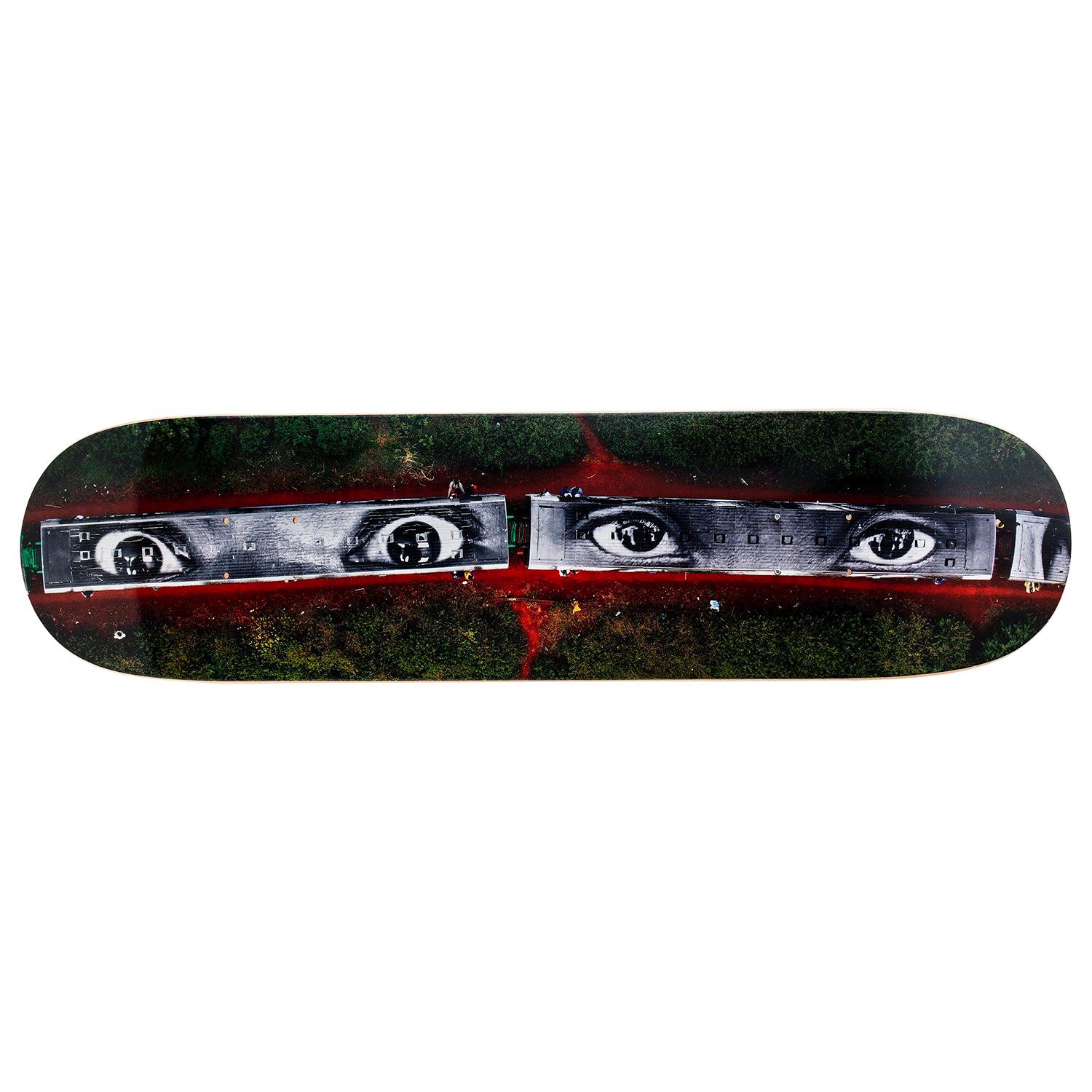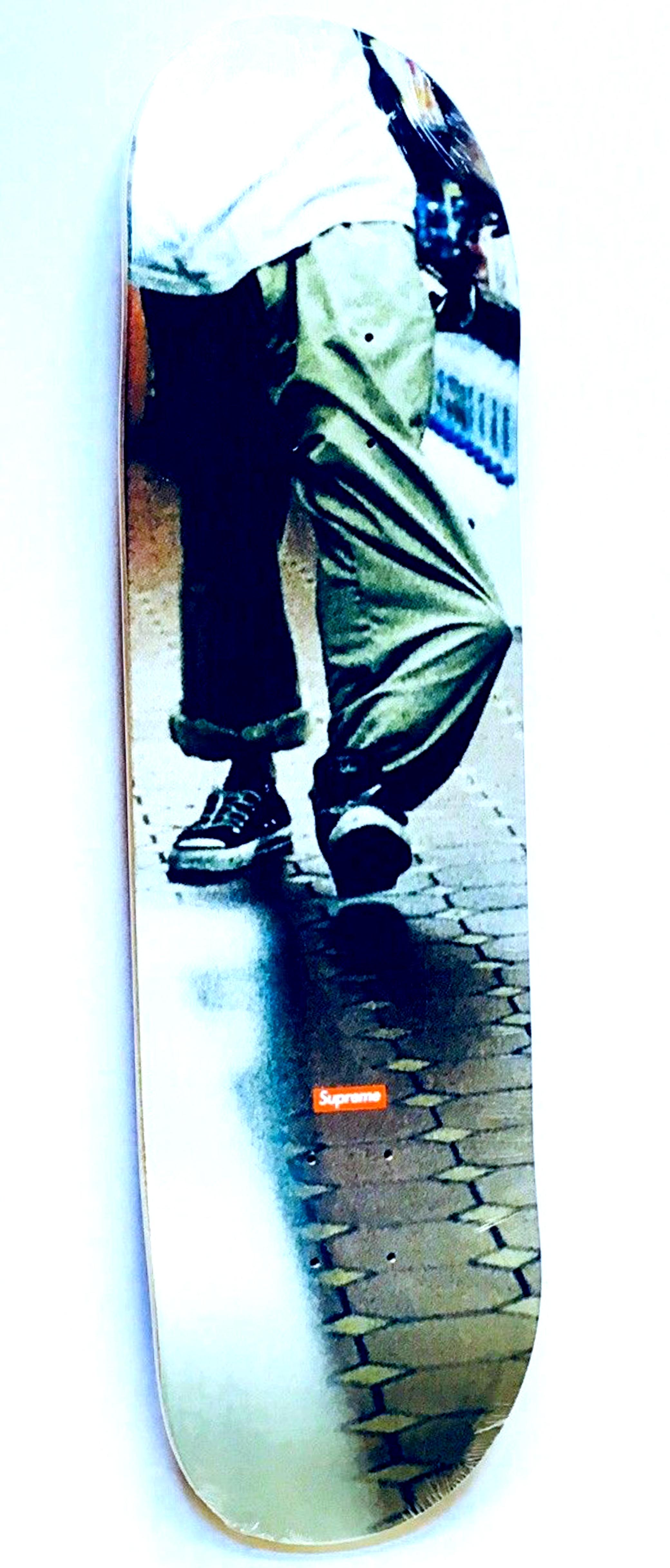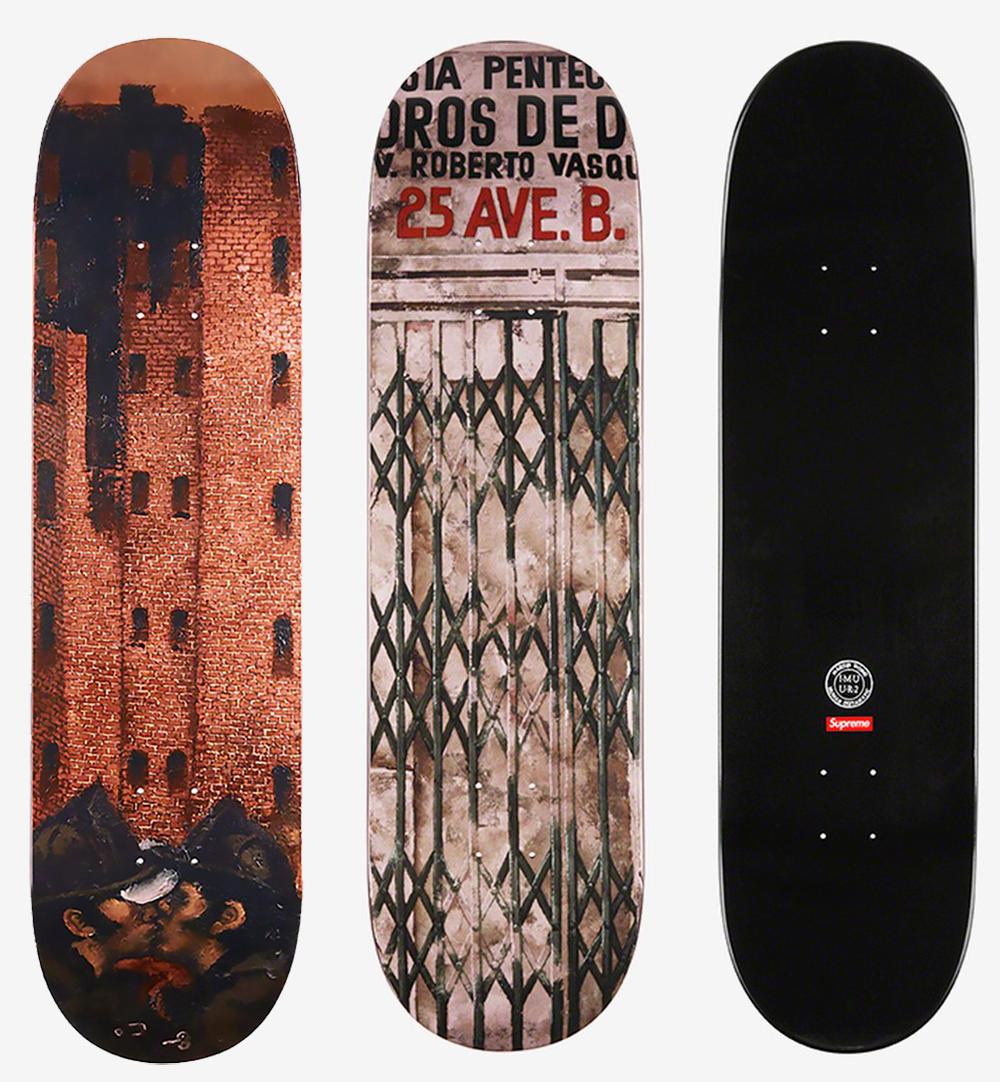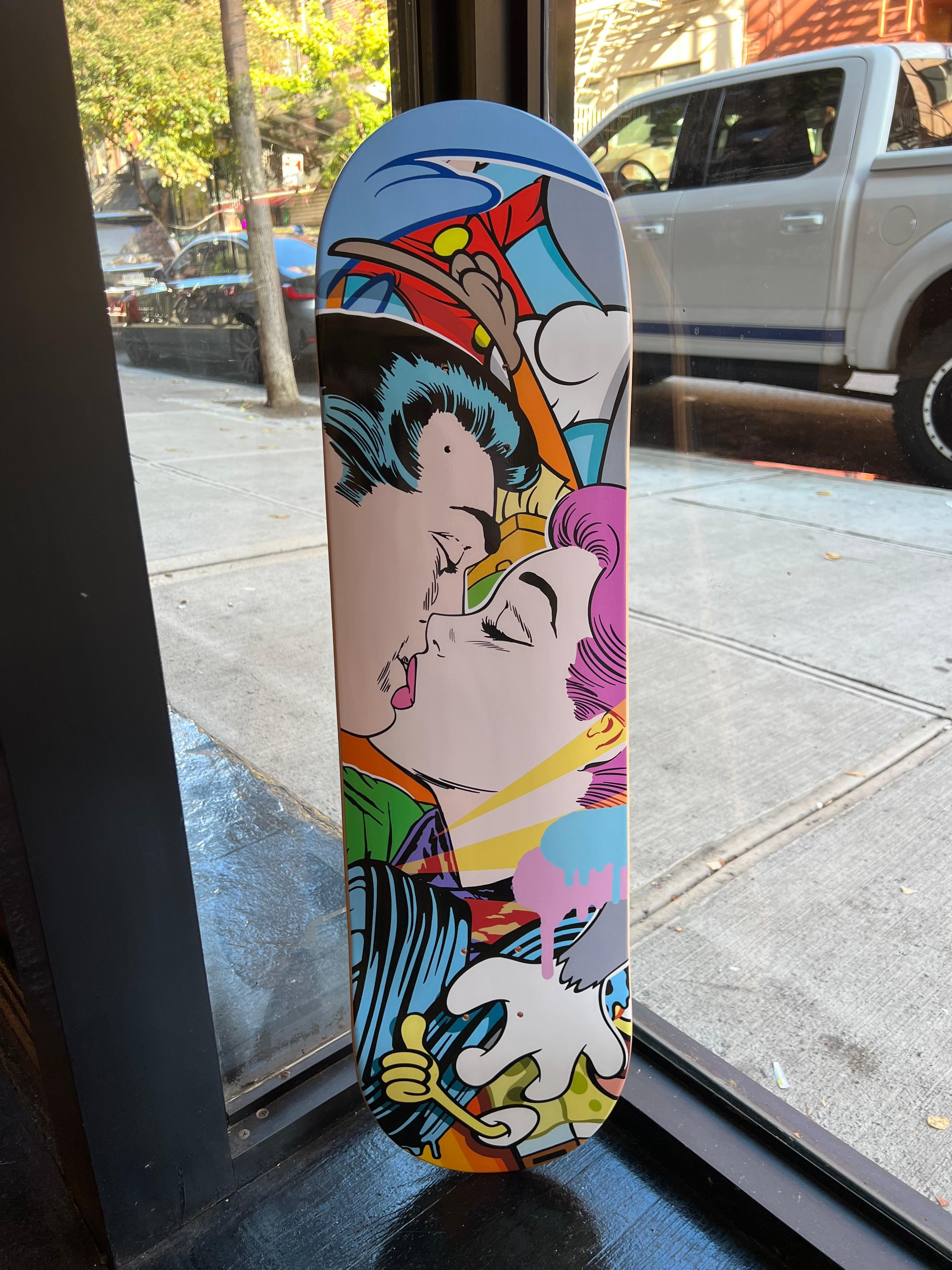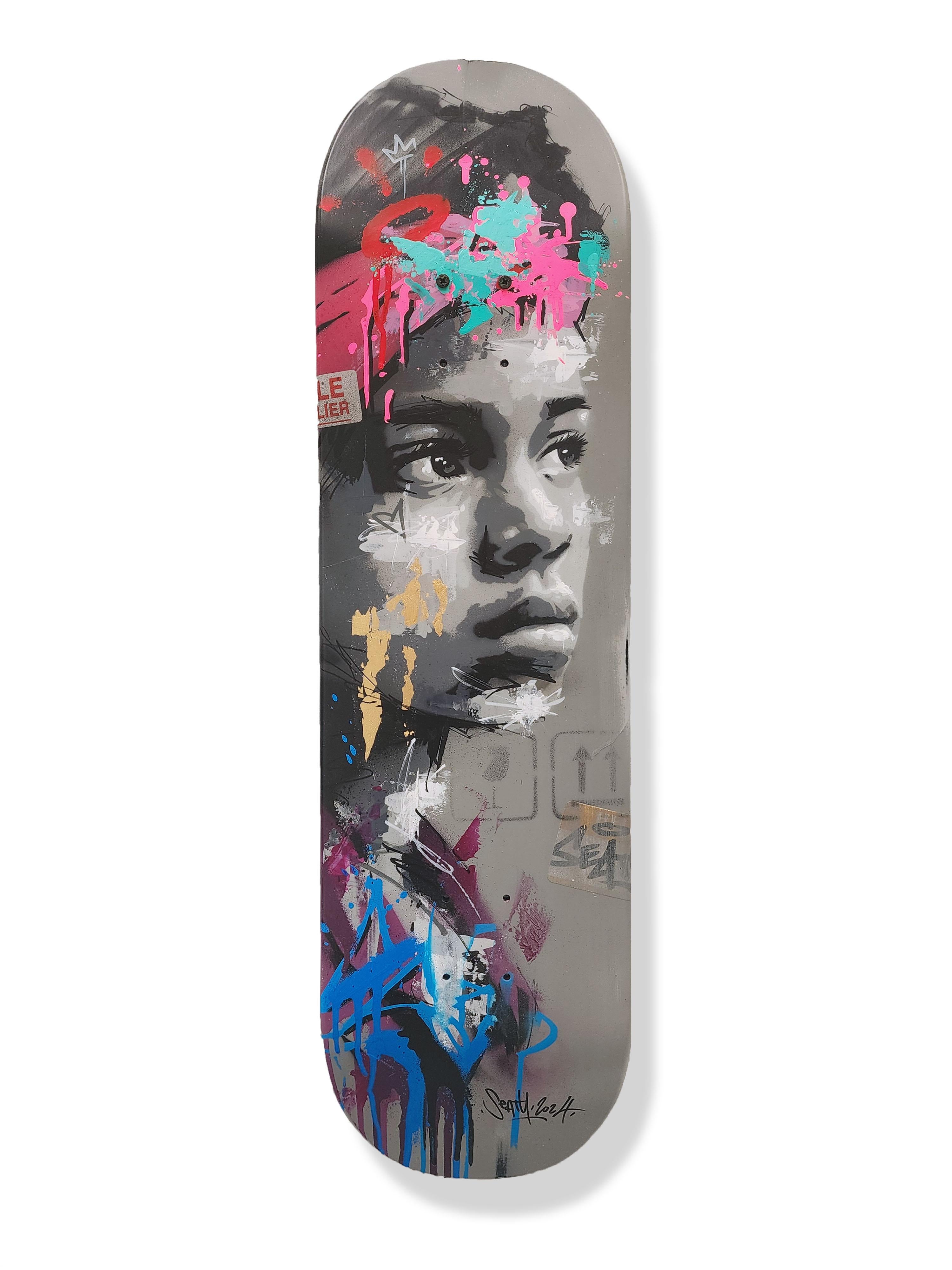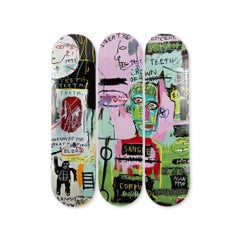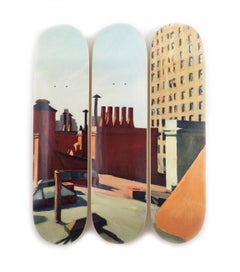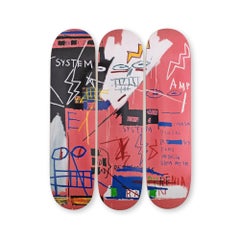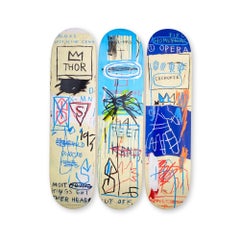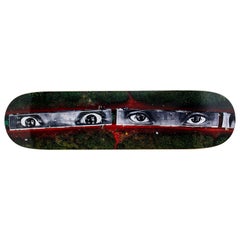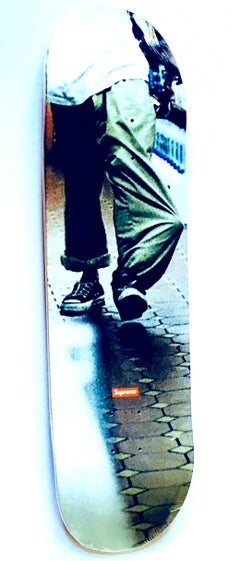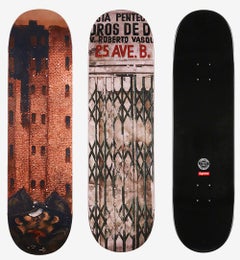Items Similar to JR MIGRANTS, WALKING NEW YORK CITY Limited edition skate set Street Art Design
Want more images or videos?
Request additional images or videos from the seller
1 of 3
JR (aka Jean René)JR MIGRANTS, WALKING NEW YORK CITY Limited edition skate set Street Art Design2019
2019
$1,597.19
£1,214.13
€1,350
CA$2,244.61
A$2,441.06
CHF 1,286.01
MX$29,647.17
NOK 16,167.70
SEK 15,155.91
DKK 10,338.12
About the Item
JR - MIGRANTS, WALKING NEW YORK CITY. NEW YORK, USA (2015)
Date of creation: 2019
Medium: Digital print on Canadian maple wood
Edition: 250
Size: 80 x 20 cm (each skate)
Condition: In mint conditions and never displayed
This work is formed by five skate decks made of 7 ply grade A Canadian maple wood. This set belongs to a numbered limited edition of 250.
The art of JR merges photography, installation, street art and social engagement. Following his 2014 work on Ellis Island, where the artist created a series of portraits of immigrants and displayed them at the island's abandoned hospital, the artist took some pictures of immigrants walking the streets of New York. The artist focused on the picture taken to Elmar Aliyev a 20-year-old waiter from Azerbaijan who immigrated to the United States after he won the green-card lottery.
One night in 2015, JR and his team pasted 62 strips of paper on the ground of the Flatiron Plaza, creating a 150-foot-tall image of Aliyev. That day people walked on his image and, just like many other immigrants, Aliyev was invisible to them.
ABOUT THE ARTIST
JR is a French artist known for his large-scale photographic works that often address social and political issues. Born on February 22, 1983, in Paris, JR grew up in the banlieues, or suburbs, surrounding the city. He first became interested in graffiti as a teenager and began creating large-scale murals in the streets. After studying at the Ecole Nationale Supérieure des Arts Décoratifs in Paris, he began experimenting with photography and street art.
In 2004, JR found his calling when he started the "Portrait of a Generation" project, a series of black-and-white portraits of young people from the banlieues. He pasted these portraits on walls and rooftops throughout the city, often in unexpected places, to give visibility to a group of people who were often marginalized in French society. The project quickly gained attention and was featured in a number of exhibitions and publications.
In 2007, JR began working on "Face 2 Face," a project that involved pasting portraits of Israelis and Palestinians face to face on both sides of the Separation Wall in the West Bank. The project was meant to challenge preconceived notions and promote dialogue between the two communities. The portraits were also displayed in various cities around the world, including Paris, Berlin, and New York.
JR continued to push the boundaries of street art and photography with his "Women Are Heroes" project in 2008. This project consisted of large-scale portraits of women from different countries, which were pasted on walls and buildings in their communities. The project aimed to celebrate women and draw attention to their struggles and the injustices they face around the world.
In 2011, JR collaborated with the film director Agnès Varda on the documentary film "Faces, Places," which followed the two artists as they traveled through rural France and created large-scale portraits of the people they met along the way. The film was a critical and commercial success, and was nominated for an Academy Award for Best Documentary Feature.
In recent years, JR has continued to create large-scale photographic works that engage with social and political issues. In 2018, he created an installation at the US-Mexico border consisting of a giant photograph of a child peering over the border wall. The installation was meant to draw attention to the issue of immigration and the separation of families at the border.
JR's work has been exhibited in galleries and museums around the world, including the Centre Pompidou in Paris, the Tate Modern in London, and the Museum of Contemporary Art in Los Angeles. He has also been awarded numerous accolades for his work, including the TED Prize in 2011 and the Robert Capa Gold Medal in 2017.
JR's work continues to inspire and provoke audiences around the world, challenging us to see the world and the people around us in new and meaningful ways.
JR (aka Jean René)
JR has the largest art gallery in the world. Thanks to his photographic collage technique, he exhibits his work free of charge on the walls of the whole world – attracting the attention of those who do not usually go to museums. Originator of the 28 Millimeters Project which he started in and around Clichy-Montfermeil in 2004, continued in the Middle East with Face 2 Face (2007), in Brazil and Kenya for Women Are Heroes (2008-2011), the documentary for which was presented at the Cannes Film Festival in 2010 (Critics' Week). JR has created "Infiltrating art". During his collage activities, the local communities take part in the act of artistic creation, with no stage separating actors from spectators. The anonymity of JR and the absence of any explanation accompanying his huge portraits leave him with a free space in which issues and actors, performers and passers-by meet, forming the essence of his work. In 2011 he received the Ted Prize, giving him the opportunity to make a vow to change the world. He created Inside Out, an international participatory art project that allows people from around the world to receive a print of their portrait and then billboard it as support for an idea, a project, an action and share that experience. In 2014, working with the New York City Ballet, he used the language of dance to tell his version of the riots in the Clichy-Montfermeil district. He created The Groves, a ballet and short film, the music for which was composed by Woodkid, Hans Zimmer and Pharrell Williams, and which was presented at the Tribeca Film Festival. At the same time, JR worked in the abandoned hospital of Ellis Island, an important place in the history of immigration – and made the short film ELLIS, with Robert De Niro. In 2016, JR was invited by the Louvre, whose pyramid he made disappear the with the help of an astonishing anamorphosis. The same year, during the Olympic Games in Rio, he created gigantic new sculptural installations throughout the city, to underline the beauty of the sporting gesture. In 2013, the first retrospectives of JR's work took place in Tokyo (at the Watari-Um Museum) and the Cincinnati Contemporary Arts Center, followed by exhibitions at the Frieder Burda Museum in Baden Baden in 2014, and at the HOCA Foundation in Hong Kong in 2015. He exhibited in 2018 at the Maison Européenne de la Photographie in Paris, and in 2019 at the San Francisco Museum of Modern Art (SFMOMA) and the Brooklyn Museum. JR is represented by Perrotin, PACE Gallery, Galleria Continua and Nara Roesler.
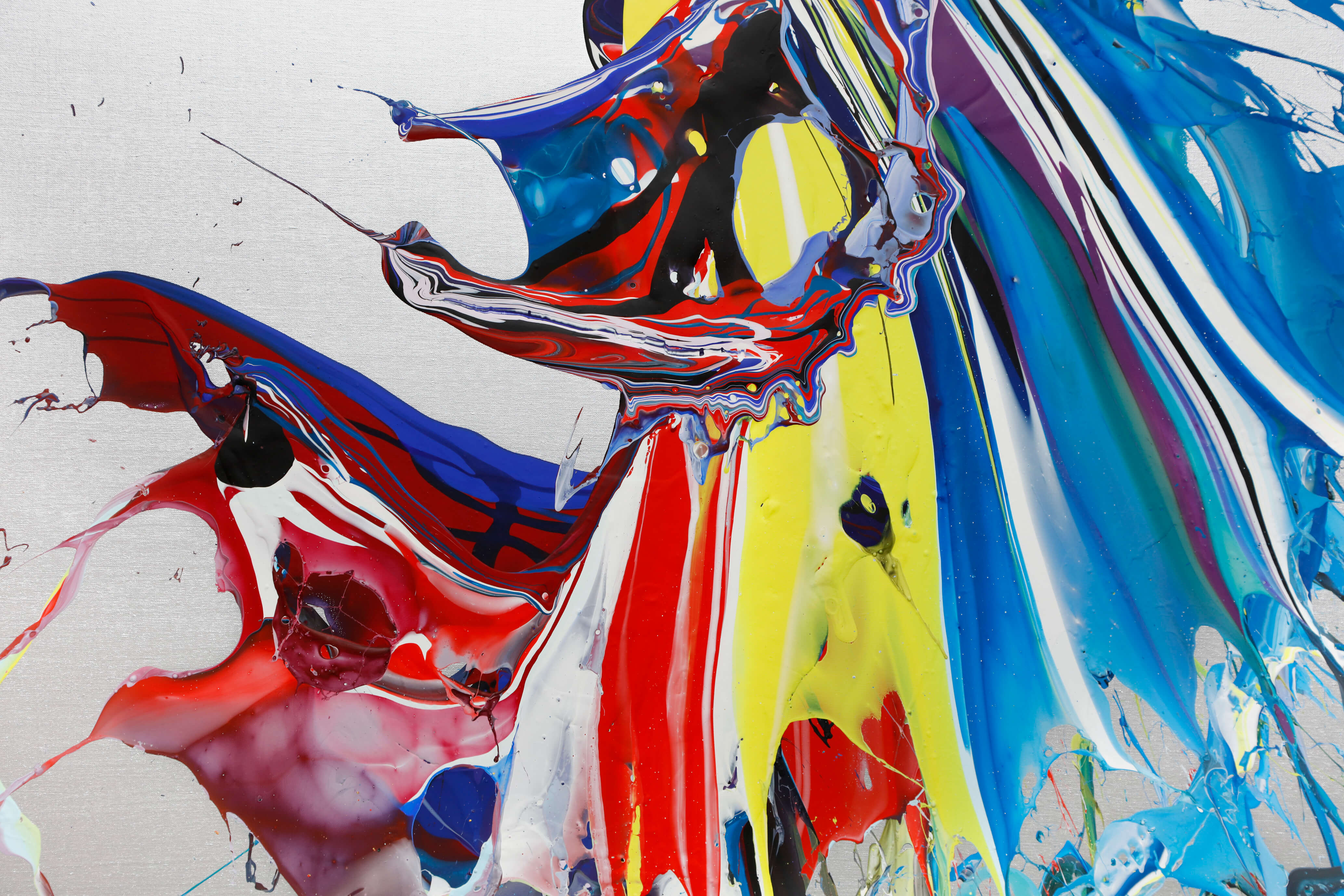
About the Seller
5.0
Vetted Professional Seller
Every seller passes strict standards for authenticity and reliability
Established in 2011
1stDibs seller since 2018
181 sales on 1stDibs
Typical response time: 14 hours
- ShippingRetrieving quote...Shipping from: Madrid, Spain
- Return Policy
Authenticity Guarantee
In the unlikely event there’s an issue with an item’s authenticity, contact us within 1 year for a full refund. DetailsMoney-Back Guarantee
If your item is not as described, is damaged in transit, or does not arrive, contact us within 7 days for a full refund. Details24-Hour Cancellation
You have a 24-hour grace period in which to reconsider your purchase, with no questions asked.Vetted Professional Sellers
Our world-class sellers must adhere to strict standards for service and quality, maintaining the integrity of our listings.Price-Match Guarantee
If you find that a seller listed the same item for a lower price elsewhere, we’ll match it.Trusted Global Delivery
Our best-in-class carrier network provides specialized shipping options worldwide, including custom delivery.More From This Seller
View AllJEAN-MICHEL BASQUIAT - In Italian. Skate Decks Pop Urban Art Design
By Jean-Michel Basquiat
Located in Madrid, Madrid
Jean-Michel Basquiat - In Italian
Date of creation: 2024
Medium: Digital print on Canadian maple wood
Edition: Open
Size: 80 x 20 cm (each skate)
Condition: In mint conditions and never displayed
This triptych is formed by three skate decks made of 7 ply grade A Canadian maple wood.
© Estate of Jean-Michel Basquiat. Licensed by Artestar, New York
In Italian (1983) is one of Jean-Michel Basquiat’s iconic works, created during a peak period of his artistic career. The piece reflects his distinctive style, blending graffiti, expressive brushwork, text, and symbolism. Like many of his paintings, "In Italian" presents a powerful and chaotic composition where words, figures, and signs interact in a raw and energetic visual language.
The title, In Italian, may suggest a reference to classical European culture—especially Italian Renaissance art—while at the same time subverting it through Basquiat’s urban, Afro-Caribbean perspective. His interest in contrasting high and low culture, refined and raw, is evident in this piece. The inclusion of text, often fragmented or cryptic, was one of Basquiat’s trademarks and serves here to provoke thought rather than deliver a clear message.
In this work, Basquiat explores themes such as identity, language, cultural heritage, and the appropriation of symbols. The figure depicted—alongside the textual elements—appears almost mythological or totemic, reinforcing Basquiat’s tendency to elevate marginalized characters into powerful, almost divine figures.
The brushstrokes are urgent, the colors bold, and the composition layered. It’s as if the viewer is meant to decipher a code—a mix of history, race, rebellion, and irony. Words in different languages, especially English and Italian, appear not to clarify meaning but to complicate it, suggesting the multilingual, multicultural environment Basquiat inhabited and commented on.
In Italian is a prime example of how Basquiat merged influences from the streets of New York with art history, African-American identity, and global culture. It's a bold visual statement that challenges traditional canons and forces the viewer to reconsider what art is, who gets to create it, and which voices are heard.
ABOUT THE ARTIST
Jean-Michel Basquiat (1960-1988) was one of the most influential artists of the 20th century, famous for his ability to fuse urban culture, social criticism and art history into a unique style. Born in Brooklyn, New York, to a Haitian father and Puerto Rican mother, his life and work were shaped by his multicultural heritage, the New York art scene and the social tensions of his time. Although his career was brief, his impact on contemporary art has been lasting and significant.
Basquiat showed an interest in art from an early age. His mother, Matilde Andrades, took him to museums and encouraged him to draw. At the age of seven, a car accident left him hospitalized for a time, and it was then that his mother gave him a copy of the anatomy book Gray's Anatomy, which influenced his fascination with the human body and its visual representation.
Despite his early talent, Basquiat's family life was turbulent. His mother was hospitalized for psychiatric problems and his relationship with his father, Gerard Basquiat, was troubled. This instability contributed to Basquiat dropping out of school at age 17 to pursue his artistic career on the streets of New York.
As a teenager, Basquiat joined the New York graffiti scene under the pseudonym SAMO (an acronym for "Same Old Shit"), which he used to sign his cryptic and poetic messages on the streets of Manhattan with his friend Al Diaz. SAMO's graffiti were a mixture of philosophical and social commentary on popular culture, capitalism and religion, and soon attracted the attention of the underground art scene.
In 1980, SAMO "died" when Basquiat and Diaz decided to end their collaboration, marking the beginning of Basquiat's transition from street graffiti to art galleries.
Basquiat emerged as a talent to watch in 1980, when he participated in the group exhibition The Times Square Show, which included other emerging artists from New York's Lower East Side scene. That same year, he attracted the attention of critics and collectors who saw in his work an electrifying blend of street art and neo-expressionism, the predominant movement of the time.
In 1981, art critic René Ricard published the influential essay The Radiant Child in Artforum magazine, which positioned Basquiat as one of the most promising artists of his generation. Shortly thereafter, he met renowned artist Andy Warhol, with whom he formed a close friendship and significant artistic collaboration. This association was instrumental in catapulting his career into the world of high art.
The collaboration with Warhol was a pivotal point in Basquiat's career. The two artists, although coming from very different worlds, shared a fascination with fame and popular culture. Together, they produced a series of works that combined Warhol's pop art icons with Basquiat's raw, spontaneous style.
However, this collaboration was also a source of controversy. Many critics accused Warhol of "exploiting" Basquiat, while others saw the collaboration as a creative dialogue between two genius minds. Although the criticism was mixed, there is no doubt that the relationship between the two artists helped cement Basquiat's reputation in the art world.
Basquiat's style is a unique amalgam of influences. His work is characterized by the use of dismembered human figures, skeletons and internal organs, evoking the fragility of the body and mortality. Basquiat also used symbols that alluded to African-American and African history, such as crowns, masks and references to historical figures such as Toussaint Louverture.
The use of text is another crucial aspect of his work. Words, phrases and numbers appeared in his paintings, often crossed out or overlapped, creating a sense of controlled chaos. These fragmented words provoked a non-linear reading of his works and conveyed multiple layers of meaning.
His art also reflected his concerns about racial issues, especially the place of people of African descent in Western art history and in society at large. The crowns that Basquiat often drew on his figures were a symbol of power and resistance, a way of proclaiming himself "king" in a world that had historically excluded black artists from the upper echelons of art.
In works such as The Death of Michael Stewart...
Category
2010s Pop Art More Art
Materials
Wood, Digital
EDWARD HOPPER - CITY ROOFS Skate Deck Modern Design Pop
By Edward Hopper
Located in Madrid, Madrid
EDWARD HOPPER - CITY ROOFS
Date of creation: 2022
Medium: Digital print on Canadian maple wood
Edition: Open
Size: 80 x 20 cm (each skate)
Condition: In mint conditions and never d...
Category
2010s Expressionist More Art
Materials
Wood, Maple, Screen
JEAN-MICHEL BASQUIAT - Six Fifty. Skate Decks Pop Urban Art Design
By Jean-Michel Basquiat
Located in Madrid, Madrid
Jean-Michel Basquiat - Six Fifty
Date of creation: 2024
Medium: Digital print on Canadian maple wood
Edition: Open
Size: 80 x 20 cm (each skate)
Condition: In mint conditions and never displayed
This triptych is formed by three skate decks made of 7 ply grade A Canadian maple wood.
© Estate of Jean-Michel Basquiat. Licensed by Artestar, New York
Six Fifty (1982) powerfully distills the symbolic universe and raw energy that define Jean-Michel Basquiat’s artistic language. In this piece, the artist uses a loaded iconography—lightning bolts, bones, swords, arrows, crowns—that serves as a kind of visual alphabet through which he explores themes of identity, violence, power, and cultural heritage.
With his gestural and spontaneous style, Basquiat turns the canvas into a field of tension between chaos and control, between the urgency of the street and the depth of critical thought. Like much of his work, this piece does not seek a single interpretation but instead opens multiple layers of meaning through graphic elements that seem to arise directly from the urban subconscious.
Six Fifty is not just a visual representation—it is a visceral statement, a fragment of the noise and pulse of 1980s New York, where Basquiat emerged as a radical voice in contemporary art. His ability to combine the immediacy of graffiti with historical, anatomical, and cultural references is fully evident here.
ABOUT THE ARTIST
Jean-Michel Basquiat (1960-1988) was one of the most influential artists of the 20th century, famous for his ability to fuse urban culture, social criticism and art history into a unique style. Born in Brooklyn, New York, to a Haitian father and Puerto Rican mother, his life and work were shaped by his multicultural heritage, the New York art scene and the social tensions of his time. Although his career was brief, his impact on contemporary art has been lasting and significant.
Basquiat showed an interest in art from an early age. His mother, Matilde Andrades, took him to museums and encouraged him to draw. At the age of seven, a car accident left him hospitalized for a time, and it was then that his mother gave him a copy of the anatomy book Gray's Anatomy, which influenced his fascination with the human body and its visual representation.
Despite his early talent, Basquiat's family life was turbulent. His mother was hospitalized for psychiatric problems and his relationship with his father, Gerard Basquiat, was troubled. This instability contributed to Basquiat dropping out of school at age 17 to pursue his artistic career on the streets of New York.
As a teenager, Basquiat joined the New York graffiti scene under the pseudonym SAMO (an acronym for "Same Old Shit"), which he used to sign his cryptic and poetic messages on the streets of Manhattan with his friend Al Diaz. SAMO's graffiti were a mixture of philosophical and social commentary on popular culture, capitalism and religion, and soon attracted the attention of the underground art scene.
In 1980, SAMO "died" when Basquiat and Diaz decided to end their collaboration, marking the beginning of Basquiat's transition from street graffiti to art galleries.
Basquiat emerged as a talent to watch in 1980, when he participated in the group exhibition The Times Square Show, which included other emerging artists from New York's Lower East Side scene. That same year, he attracted the attention of critics and collectors who saw in his work an electrifying blend of street art and neo-expressionism, the predominant movement of the time.
In 1981, art critic René Ricard published the influential essay The Radiant Child in Artforum magazine, which positioned Basquiat as one of the most promising artists of his generation. Shortly thereafter, he met renowned artist Andy Warhol, with whom he formed a close friendship and significant artistic collaboration. This association was instrumental in catapulting his career into the world of high art.
The collaboration with Warhol was a pivotal point in Basquiat's career. The two artists, although coming from very different worlds, shared a fascination with fame and popular culture. Together, they produced a series of works that combined Warhol's pop art icons with Basquiat's raw, spontaneous style.
However, this collaboration was also a source of controversy. Many critics accused Warhol of "exploiting" Basquiat, while others saw the collaboration as a creative dialogue between two genius minds. Although the criticism was mixed, there is no doubt that the relationship between the two artists helped cement Basquiat's reputation in the art world.
Basquiat's style is a unique amalgam of influences. His work is characterized by the use of dismembered human figures, skeletons and internal organs, evoking the fragility of the body and mortality. Basquiat also used symbols that alluded to African-American and African history, such as crowns, masks and references to historical figures such as Toussaint Louverture.
The use of text is another crucial aspect of his work. Words, phrases and numbers appeared in his paintings, often crossed out or overlapped, creating a sense of controlled chaos. These fragmented words provoked a non-linear reading of his works and conveyed multiple layers of meaning.
His art also reflected his concerns about racial issues, especially the place of people of African descent in Western art history and in society at large. The crowns that Basquiat often drew on his figures were a symbol of power and resistance, a way of proclaiming himself "king" in a world that had historically excluded black artists from the upper echelons of art.
In works such as The Death of Michael...
Category
2010s Pop Art More Art
Materials
Wood, Digital
JEAN-MICHEL BASQUIAT - Charles The First. Skate Decks Pop Urban Art Design
By Jean-Michel Basquiat
Located in Madrid, Madrid
Jean-Michel Basquiat - Charles The First
Date of creation: 2024
Medium: Digital print on Canadian maple wood
Edition: Open
Size: 80 x 20 cm (each skate)
Condition: In mint conditions and never displayed
This triptych is formed by three skate decks made of 7 ply grade A Canadian maple wood.
© Estate of Jean-Michel Basquiat. Licensed by Artestar, New York
This skateboard set reproduces Charles The First (1982), a key work by Jean-Michel Basquiat that pays tribute to Charlie Parker, the influential jazz saxophonist known as "Bird." Basquiat captures the frantic energy and complexity of Parker through his signature style, blending elements of Black culture, music, and the figure of the artist in a raw and powerful representation.
The original painting, executed with acrylics, oils, and pastels, presents a stylized figure that recalls both a portrait and a symbol. The face is fragmented, filled with quick strokes and vibrant colors, while the outline and details evoke both divinity and struggle. Basquiat uses his unique visual language to convey the chaos and beauty of Parker’s life, a metaphor for creativity as a form of resistance and expression.
Transposed onto the skateboard format, Charles The First becomes a dynamic work of art that not only celebrates the life of a musical icon but also merges contemporary art with urban culture. This piece transcends simple reproduction, inviting a connection between visual art and movement in the streets, with the same vigor and attitude Basquiat infused into his work.
ABOUT THE ARTIST
Jean-Michel Basquiat (1960-1988) was one of the most influential artists of the 20th century, famous for his ability to fuse urban culture, social criticism and art history into a unique style. Born in Brooklyn, New York, to a Haitian father and Puerto Rican mother, his life and work were shaped by his multicultural heritage, the New York art scene and the social tensions of his time. Although his career was brief, his impact on contemporary art has been lasting and significant.
Basquiat showed an interest in art from an early age. His mother, Matilde Andrades, took him to museums and encouraged him to draw. At the age of seven, a car accident left him hospitalized for a time, and it was then that his mother gave him a copy of the anatomy book Gray's Anatomy, which influenced his fascination with the human body and its visual representation.
Despite his early talent, Basquiat's family life was turbulent. His mother was hospitalized for psychiatric problems and his relationship with his father, Gerard Basquiat, was troubled. This instability contributed to Basquiat dropping out of school at age 17 to pursue his artistic career on the streets of New York.
As a teenager, Basquiat joined the New York graffiti scene under the pseudonym SAMO (an acronym for "Same Old Shit"), which he used to sign his cryptic and poetic messages on the streets of Manhattan with his friend Al Diaz. SAMO's graffiti were a mixture of philosophical and social commentary on popular culture, capitalism and religion, and soon attracted the attention of the underground art scene.
In 1980, SAMO "died" when Basquiat and Diaz decided to end their collaboration, marking the beginning of Basquiat's transition from street graffiti to art galleries.
Basquiat emerged as a talent to watch in 1980, when he participated in the group exhibition The Times Square Show, which included other emerging artists from New York's Lower East Side scene. That same year, he attracted the attention of critics and collectors who saw in his work an electrifying blend of street art and neo-expressionism, the predominant movement of the time.
In 1981, art critic René Ricard published the influential essay The Radiant Child in Artforum magazine, which positioned Basquiat as one of the most promising artists of his generation. Shortly thereafter, he met renowned artist Andy Warhol, with whom he formed a close friendship and significant artistic collaboration. This association was instrumental in catapulting his career into the world of high art.
The collaboration with Warhol was a pivotal point in Basquiat's career. The two artists, although coming from very different worlds, shared a fascination with fame and popular culture. Together, they produced a series of works that combined Warhol's pop art icons with Basquiat's raw, spontaneous style.
However, this collaboration was also a source of controversy. Many critics accused Warhol of "exploiting" Basquiat, while others saw the collaboration as a creative dialogue between two genius minds. Although the criticism was mixed, there is no doubt that the relationship between the two artists helped cement Basquiat's reputation in the art world.
Basquiat's style is a unique amalgam of influences. His work is characterized by the use of dismembered human figures, skeletons and internal organs, evoking the fragility of the body and mortality. Basquiat also used symbols that alluded to African-American and African history, such as crowns, masks and references to historical figures such as Toussaint Louverture.
The use of text is another crucial aspect of his work. Words, phrases and numbers appeared in his paintings, often crossed out or overlapped, creating a sense of controlled chaos. These fragmented words provoked a non-linear reading of his works and conveyed multiple layers of meaning.
His art also reflected his concerns about racial issues, especially the place of people of African descent in Western art history and in society at large. The crowns that Basquiat often drew on his figures were a symbol of power and resistance, a way of proclaiming himself "king" in a world that had historically excluded black artists from the upper echelons of art.
In works such as The Death of Michael Stewart...
Category
2010s Pop Art More Art
Materials
Wood, Digital
JEAN-MICHEL BASQUIAT - Both Poles. Skate Decks Pop Urban Art Design
By Jean-Michel Basquiat
Located in Madrid, Madrid
Jean-Michel Basquiat - Both Poles
Date of creation: 2024
Medium: Digital print on Canadian maple wood
Edition: Open
Size: 80 x 20 cm (each skate)
Condition: In mint conditions and never displayed
This triptych is formed by three skate decks made of 7 ply grade A Canadian maple wood.
© Estate of Jean-Michel Basquiat. Licensed by Artestar, New York
This skateboard set reproduces Both Poles (1982), an iconic work by Jean-Michel Basquiat that encapsulates the tensions running through his visual language: past and present, earth and sky, history and immediacy. The original piece, executed in acrylic, oil stick, and collage, presents a fragmented scene dominated by a symbolic mountain, a crescent moon, and charged elements such as a sickle and a post.
Here, Basquiat confronts “both poles” of his inner and outer worlds: excavation and invocation, memory and transmission. This edition brings that conceptual force into the urban language of skateboarding, becoming both a collectible object and a contemporary artistic statement.
Transposed onto the skateboard format, the work becomes a visual declaration that bridges art and street culture, while preserving the expressive and conceptual intensity of the original.
ABOUT THE ARTIST
Jean-Michel Basquiat (1960-1988) was one of the most influential artists of the 20th century, famous for his ability to fuse urban culture, social criticism and art history into a unique style. Born in Brooklyn, New York, to a Haitian father and Puerto Rican mother, his life and work were shaped by his multicultural heritage, the New York art scene and the social tensions of his time. Although his career was brief, his impact on contemporary art has been lasting and significant.
Basquiat showed an interest in art from an early age. His mother, Matilde Andrades, took him to museums and encouraged him to draw. At the age of seven, a car accident left him hospitalized for a time, and it was then that his mother gave him a copy of the anatomy book Gray's Anatomy, which influenced his fascination with the human body and its visual representation.
Despite his early talent, Basquiat's family life was turbulent. His mother was hospitalized for psychiatric problems and his relationship with his father, Gerard Basquiat, was troubled. This instability contributed to Basquiat dropping out of school at age 17 to pursue his artistic career on the streets of New York.
As a teenager, Basquiat joined the New York graffiti scene under the pseudonym SAMO (an acronym for "Same Old Shit"), which he used to sign his cryptic and poetic messages on the streets of Manhattan with his friend Al Diaz. SAMO's graffiti were a mixture of philosophical and social commentary on popular culture, capitalism and religion, and soon attracted the attention of the underground art scene.
In 1980, SAMO "died" when Basquiat and Diaz decided to end their collaboration, marking the beginning of Basquiat's transition from street graffiti to art galleries.
Basquiat emerged as a talent to watch in 1980, when he participated in the group exhibition The Times Square Show, which included other emerging artists from New York's Lower East Side scene. That same year, he attracted the attention of critics and collectors who saw in his work an electrifying blend of street art and neo-expressionism, the predominant movement of the time.
In 1981, art critic René Ricard published the influential essay The Radiant Child in Artforum magazine, which positioned Basquiat as one of the most promising artists of his generation. Shortly thereafter, he met renowned artist Andy Warhol, with whom he formed a close friendship and significant artistic collaboration. This association was instrumental in catapulting his career into the world of high art.
The collaboration with Warhol was a pivotal point in Basquiat's career. The two artists, although coming from very different worlds, shared a fascination with fame and popular culture. Together, they produced a series of works that combined Warhol's pop art icons with Basquiat's raw, spontaneous style.
However, this collaboration was also a source of controversy. Many critics accused Warhol of "exploiting" Basquiat, while others saw the collaboration as a creative dialogue between two genius minds. Although the criticism was mixed, there is no doubt that the relationship between the two artists helped cement Basquiat's reputation in the art world.
Basquiat's style is a unique amalgam of influences. His work is characterized by the use of dismembered human figures, skeletons and internal organs, evoking the fragility of the body and mortality. Basquiat also used symbols that alluded to African-American and African history, such as crowns, masks and references to historical figures such as Toussaint Louverture.
The use of text is another crucial aspect of his work. Words, phrases and numbers appeared in his paintings, often crossed out or overlapped, creating a sense of controlled chaos. These fragmented words provoked a non-linear reading of his works and conveyed multiple layers of meaning.
His art also reflected his concerns about racial issues, especially the place of people of African descent in Western art history and in society at large. The crowns that Basquiat often drew on his figures were a symbol of power and resistance, a way of proclaiming himself "king" in a world that had historically excluded black artists from the upper echelons of art.
In works such as The Death of Michael...
Category
2010s Pop Art More Art
Materials
Wood, Digital
JEAN-MICHEL BASQUIAT - Untitled Head (Skull) Skate Decks Urban Art Design
By Jean-Michel Basquiat
Located in Madrid, Madrid
Jean-Michel Basquiat - Untitled Head (Skull 2), 1982
Date of creation: 2024
Medium: Digital print on Canadian maple wood
Edition: Open
Size: 80 x 20 cm (each skate)
Condition: In mint conditions and never displayed
This triptych is formed by three skate decks made of 7 ply grade A Canadian maple wood.
© Estate of Jean-Michel Basquiat. Licensed by Artestar, New York
Untitled Head (Skull 2), 1982, is one of Jean-Michel Basquiat’s most iconic and enigmatic works, reflecting the artist’s complex relationship with life, death, and identity. Created during an early but intense phase of his career, this piece is characterized by its raw, expressive style, but also by its ability to convey a deep and multifaceted message.
The painting depicts a large skull, both grotesque and vibrant. The outlines of the skull are simple yet powerful, with angular strokes and dramatic lines. Basquiat uses a contrasting color palette, dominated by warm, earthy tones such as red, orange, and yellow, along with touches of blue and white. The skull seems to overflow with energy, full of marks and textures that evoke a sense of violence and chaos.
The skull is not only a symbol of death, but also carries connotations of internal struggle and personal suffering. Basquiat, known for his personal history marked by adversity, uses the figure of the skull to explore themes such as the fragility of life and the dehumanization of people, especially in African American communities. In his work, death is not presented merely as an abstract concept, but as something very real and close, connected to the everyday experience of those facing violence, racism, and poverty.
Through this piece, Basquiat also addresses identity and alienation, as the skull, with its exaggerated and distorted features, can be seen as a representation of an individual stripped of their humanity or cultural identity, particularly in the context of the experiences of Black communities in the United States. Basquiat often incorporates words, phrases, and symbols in his works that reflect his interest in cryptic messages and the deconstruction of meaning, and Untitled Head (Skull 2), is no exception.
The skull, often associated with mortality, in Basquiat’s context may also suggest the relentless presence of social oppression and how, in many cases, people’s lives are shaped by circumstances beyond their control. This approach to death is Basquiat’s way of engaging with the collective and personal traumas that defined his life, as well as the racial and social tensions of his time.
Untitled Head (Skull 2) is a work full of energy, with a strong symbolic charge, that breaks away from convention and offers a raw, direct view of life, death, and existential struggle. It is an example of how Basquiat used art to express his deepest emotions, challenging traditional representation and creating a piece that remains relevant today, both for its message and its unique style.
ABOUT THE ARTIST
Jean-Michel Basquiat (1960-1988) was one of the most influential artists of the 20th century, famous for his ability to fuse urban culture, social criticism and art history into a unique style. Born in Brooklyn, New York, to a Haitian father and Puerto Rican mother, his life and work were shaped by his multicultural heritage, the New York art scene and the social tensions of his time. Although his career was brief, his impact on contemporary art has been lasting and significant.
Basquiat showed an interest in art from an early age. His mother, Matilde Andrades, took him to museums and encouraged him to draw. At the age of seven, a car accident left him hospitalized for a time, and it was then that his mother gave him a copy of the anatomy book Gray's Anatomy, which influenced his fascination with the human body and its visual representation.
Despite his early talent, Basquiat's family life was turbulent. His mother was hospitalized for psychiatric problems and his relationship with his father, Gerard Basquiat, was troubled. This instability contributed to Basquiat dropping out of school at age 17 to pursue his artistic career on the streets of New York.
As a teenager, Basquiat joined the New York graffiti scene under the pseudonym SAMO (an acronym for "Same Old Shit"), which he used to sign his cryptic and poetic messages on the streets of Manhattan with his friend Al Diaz. SAMO's graffiti were a mixture of philosophical and social commentary on popular culture, capitalism and religion, and soon attracted the attention of the underground art scene.
In 1980, SAMO "died" when Basquiat and Diaz decided to end their collaboration, marking the beginning of Basquiat's transition from street graffiti to art galleries.
Basquiat emerged as a talent to watch in 1980, when he participated in the group exhibition The Times Square Show, which included other emerging artists from New York's Lower East Side scene. That same year, he attracted the attention of critics and collectors who saw in his work an electrifying blend of street art and neo-expressionism, the predominant movement of the time.
In 1981, art critic René Ricard published the influential essay The Radiant Child in Artforum magazine, which positioned Basquiat as one of the most promising artists of his generation. Shortly thereafter, he met renowned artist Andy Warhol, with whom he formed a close friendship and significant artistic collaboration. This association was instrumental in catapulting his career into the world of high art.
The collaboration with Warhol was a pivotal point in Basquiat's career. The two artists, although coming from very different worlds, shared a fascination with fame and popular culture. Together, they produced a series of works that combined Warhol's pop art icons with Basquiat's raw, spontaneous style.
However, this collaboration was also a source of controversy. Many critics accused Warhol of "exploiting" Basquiat, while others saw the collaboration as a creative dialogue between two genius minds. Although the criticism was mixed, there is no doubt that the relationship between the two artists helped cement Basquiat's reputation in the art world.
Basquiat's style is a unique amalgam of influences. His work is characterized by the use of dismembered human figures, skeletons and internal organs, evoking the fragility of the body and mortality. Basquiat also used symbols that alluded to African-American and African history, such as crowns, masks and references to historical figures such as Toussaint Louverture.
The use of text is another crucial aspect of his work. Words, phrases and numbers appeared in his paintings, often crossed out or overlapped, creating a sense of controlled chaos. These fragmented words provoked a non-linear reading of his works and conveyed multiple layers of meaning.
His art also reflected his concerns about racial issues, especially the place of people of African descent in Western art history and in society at large. The crowns that Basquiat often drew on his figures were a symbol of power and resistance, a way of proclaiming himself "king" in a world that had historically excluded black artists from the upper echelons of art.
In works such as The Death of Michael...
Category
2010s Pop Art More Art
Materials
Wood, Digital
You May Also Like
28 MILLIMÈTRES... Skateboard Deck by JR
By Prune Nourry and JR
Located in Jersey City, NJ
Fabricated by The Skateroom
Based on 28 MILLIMÈTRES, WOMEN ARE HEROES, ACTION IN KIBERA SLUM, « IN TO THE WILD », KENYA, 2009
One skateboard deck
7-ply Canadian Maplewood with scr...
Category
2010s Belgian Wall-mounted Sculptures
Materials
Maple
$350 / item
Untitled Larry Clark Kids Skateboard Skate deck
By Larry Clark
Located in New York, NY
Larry Clark
Untitled Larry Clark Kids Skateboard Skate deck, 2013
Screenprint on 7-ply Canadian maplewood skatedeck
Signed on the deck
31 × 8 inches
Long sold out 2013 skateboard dec...
Category
2010s Contemporary Figurative Prints
Materials
Maple, Mixed Media, Screen
Martin Wong Supreme set of 2 skateboard decks (Martin Wong Supreme)
By Supreme
Located in NEW YORK, NY
Martin Wong Supreme Skateboard Decks, 2019 (set of 2):
– 'Big Heat', 1986.
– 'Iglesia Pentecostal', 1986.
Set of 2 limited edition Martin Wong skateboard p...
Category
21st Century and Contemporary Photorealist Mixed Media
Materials
Wood, Screen
$400 Sale Price
20% Off
Covid-19 New York: Skateboarder on Empty Park Avenue
By Mitchell Funk
Located in Miami, FL
Shipping should be around $100. Mitchell Funk
Covid-19 New York: Skateboarder on Empty Park Avenue
Inkjet Archival Print
43 × 29 in
Signed, dated lower and numbered 3/15 lower rig...
Category
2010s Modern Figurative Photography
Materials
Inkjet
street art artist Bustart "Skate Pop Love" Pop Art print on skatedeck
By Bustart
Located in New York, NY
Skatedeck print
In 1999 BustArt began his artistic career with classic Graffiti. Until 2005, he became familiar with the whole spectrum of Graffiti and reached a new level of identi...
Category
2010s Street Art Figurative Prints
Materials
Acrylic, Wood Panel
Harlem
Located in PARIS, FR
Original and unique painting by french street-artist SEATY.
Dimensions of the artwork including the frame: 96 x 38 cm.
"HARLEM" by French artist Seaty is a captivating artwork pain...
Category
2010s Street Art Figurative Paintings
Materials
Acrylic, Wood
$6,625 Sale Price
20% Off
